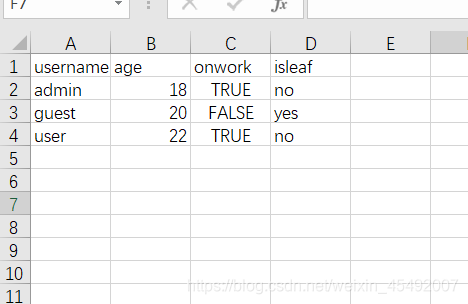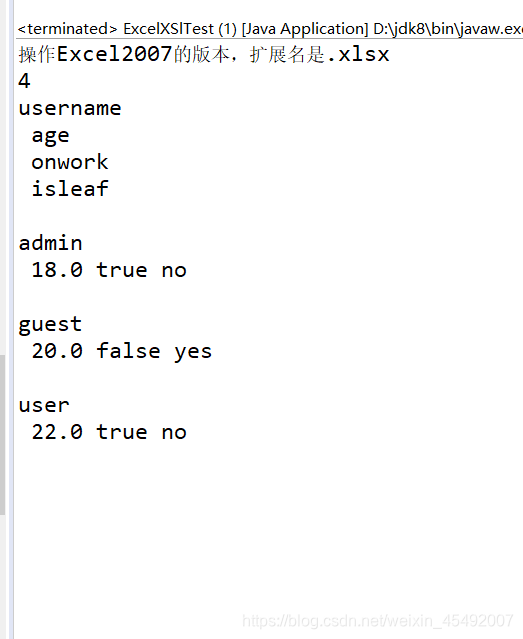1.pom依赖
<!-- https://mvnrepository.com/artifact/org.apache.poi/poi -->
<dependency>
<groupId>org.apache.poi</groupId>
<artifactId>poi</artifactId>
<version>4.1.1</version>
</dependency>
<!--处理2007 excel-->
<dependency>
<groupId>org.apache.poi</groupId>
<artifactId>poi-ooxml</artifactId>
<version>4.1.1</version>
</dependency>
2.创建一个excel文件:test.xlsx文件

然后将其放入src下面
3.开始查找可以解析的类
查看apache的简介

发现了这个Workbook这个类,查看它的子类

发现可以使用的又两个一个是HSSFWorkbook(操作Excel2003以前(包括2003)的版本,扩展名是.xls)和XSSFWorkbook(操作Excel2007的版本,扩展名是.xlsx)
4.开始使用
由于当前的操作的excel的版本和工具有两个所以需要通过扩展名查看,获取对应解析的类型的实例
// 通过当前的文件类型加载所诉要的模板
// xlsx需要使用XSSFWorkbook
// xls需要使用HSSFWorkbook
public static Workbook getWorkBookByEngine(String filePath) throws Exception {
int indexOf = filePath.indexOf(".");
String type = filePath.substring(indexOf + 1, filePath.length());
Workbook workbook = null;
InputStream is = Thread.currentThread().getContextClassLoader().getResourceAsStream(filePath);
try {
switch (type) {
case "xlsx":
workbook = new XSSFWorkbook(is);
System.out.println("操作Excel2007的版本,扩展名是.xlsx");
break;
case "xls":
workbook = new HSSFWorkbook(is);
System.out.println("操作Excel2003以前(包括2003)的版本,扩展名是.xls");
break;
default:
throw new IllegalArgumentException("不能解析的文件类型!");
}
} catch (Exception e) {
closeWorkBook(workbook);
closeInputStream(is);
e.printStackTrace();
throw new Exception(e);
} finally {
closeInputStream(is);
}
return workbook;
}
public static void closeInputStream(InputStream is) {
if (is != null)
try {
is.close();
} catch (IOException ex) {
ex.printStackTrace();
}
}
public static void closeWorkBook(Workbook workBook) {
if (workBook != null)
try {
workBook.close();
} catch (IOException ex) {
ex.printStackTrace();
}
}
创建读取数据的方法
public static void readExcelFile() {
Workbook workbook = null;
try {
workbook=MyExcelUtils.getWorkBookByEngine("test.xlsx");
Iterator<Sheet> iterator = workbook.iterator();
while (iterator.hasNext()) {
Sheet sheet = iterator.next();
//先获取当前的最大行号(就是当前的数据行数减+1?)
int lasRowNum=sheet.getLastRowNum()+1;
System.out.println(lasRowNum);
//循环的方式获取当前的每一行
for (int i = 0; i < lasRowNum; i++) {
Row row = sheet.getRow(i);
//获取当前的最后一列的数量
short lastCellNum = row.getLastCellNum();
for (int j = 0; j <lastCellNum; j++) {
//获取每一个单元
Cell cell = row.getCell(j);
//获取当前这个单元格的数据类型
CellType cellType = cell.getCellType();
if(cellType==CellType.NUMERIC) {
System.out.print(cell.getNumericCellValue());
}else if(cellType==CellType.BOOLEAN) {
System.out.print(cell.getBooleanCellValue());
}else {
System.out.println(cell.getStringCellValue());
}
System.out.print(" ");
}
System.out.println();
}
}
} catch (Exception e) {
e.printStackTrace();
} finally {
try {
if (workbook != null)
workbook.close();
} catch (IOException e) {
e.printStackTrace();
}
}
}
1.通过解析发现了一些问题在获取当前行的行数的时候需要使用getLastRowNum获取最大的行数(这个数还需要+1才是正确的)
2.而当前的获取的单元格的行数为getLastCellNum方法(这个不需要+1)
3.在获取单元格的数据的时候需要注意获取的类型,如果类型不匹配的话就会报错!
5.结果

读取成功!
6.总结
1.从当前获取的数据可以看到poi将excel分为:Sheet、Row、Cell,其中一个Sheet种可以有多个Row,一个Row种可以有多个Cell
2.需要注意当前的Cell获取的数据类型,不匹配会报错
3.需要注意使用的excel的版本,错误的版本也会操作失败
以上纯属个人见解,如有问题请联系本人!





 本文介绍如何使用Apache POI库解析不同版本的Excel文件。详细解释了如何通过文件扩展名选择正确的Workbook实现类,提供了读取Excel数据的示例代码,并讨论了处理不同单元格类型和版本的重要性。
本文介绍如何使用Apache POI库解析不同版本的Excel文件。详细解释了如何通过文件扩展名选择正确的Workbook实现类,提供了读取Excel数据的示例代码,并讨论了处理不同单元格类型和版本的重要性。
















 3217
3217

 被折叠的 条评论
为什么被折叠?
被折叠的 条评论
为什么被折叠?








